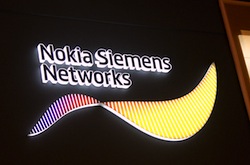In what the two European telecoms companies are calling the “biggest transformation in the role of the base station” since launch of GSM 22 years ago, German-Finnish manufacturing partners Nokia Siemens Networks has just announced the launch of what it calls a “fundamental” changing of the role of the base station in the mobile network.
According to NSN, since tGSM’s commercial launch in 1991, cellular base stations have been the part of the network that merely transmits and receives radio signals to create a connection with a mobile device. NSN said it has transformed the base station into an intelligent part of a mobile network. This new smart base station concept will be able to serve and deliver local content.
NSN said that by turning the base station into a place where any type of content and data can be stored knowing where and why people are using their devices, by placing useful content on the edge of networks, operators can now offer better service delivery as well as increasing network efficiency.
Dubbed ‘Liquid Applications’, the new smart base station tech enables application data to flow across the mobile network to the base stations where it can be delivered instantly to local subscribers. Information about the area surrounding the base station, such as that used in augmented reality applications, or news and video content can be placed at the base station for instant local access to connected devices. NSN’s Liquid Applications are enabled by the company’s new Radio Applications Cloud Server (RACS) that handles localized processing, as well as content storage, access to real-time radio and network information – all in the base station. By turning base stations into local hubs for service creation and delivery, Liquid Applications helps operators offer a service experience that is local and personal. It works hand in hand with existing charging, messaging and location-based services and is part of Nokia Siemens Networks’ Liquid Broadband portfolio.
Emeka Obiodu, telco strategy analyst for Ovum commented: “NSN proclaims this as the biggest transformation in the role of the base station since the launch of GSM 22 years ago. This is true to an extent, although we note that NSN is not the first vendor to tout local caching at the base station. Much smaller vendors like Altobridge have developed similar local caching solutions.” She added: “But this is still a big development for the mobile industry. Research consistently shows that consumers use their mobile phones predominantly when at home or in the office. Therefore, it is logical to map user preferences and provide local intelligence at the base station. This extension of intelligence from the core to the base station is thus something to watch in the next few years.”
Gabriel Brown, senior telecoms industry analyst for Heavy Reading, noted: “Also placing services close to the user is a step toward creating a network architecture that prepares mobile operators for content-heavy, performance-orientated service models that will be critical to competitive advantage in the future.”
“NSN has also signed up IBM as a partner to deliver the mobile edge computing platform” Ovum’s Obiodu added, “and is lining up a telco partner to be unveiled soon.”
Liquid Applications is a key component of NSN’s Liquid Broadband portfolio, comprising QoS Differentiation and operator Content Delivery Network (CDN).



